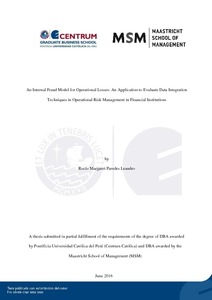| dc.contributor.advisor | Vincent, Charles | |
| dc.contributor.author | Paredes Leandro, Rocío Margaret | |
| dc.date.accessioned | 2017-03-02T15:49:53Z | |
| dc.date.available | 2017-03-02T15:49:53Z | |
| dc.date.created | 2016 | |
| dc.date.issued | 2017-03-02 | |
| dc.identifier.uri | http://hdl.handle.net/20.500.12404/7998 | |
| dc.description.abstract | The handling of external operational loss data by individual banks is one of the longstanding
problems in risk management theory and practice. The extant literature has not
provided a method to identify the best way to combine internal and external operational loss
data to calculate operational risk capital. Hence, to improve the knowledge and understanding
of internal-external data combination in operational risk management, this study applied a
simulation-based evaluation of well-known data combination techniques such as the scaling,
the Bayesian, and the covariate-base techniques.
This research considered operational losses arising from internal fraud in retail
banking within a group of international banks that share data through an operational loss data
exchange. One of the key elements of the simulation-based statistical evaluation was the
development of a dynamic internal fraud model for operational losses in retail banking. The
internal fraud model incorporated human factors such as the number of employees per branch
and the ethical quality of workers. It also included the extent of risk controls set by bank
managers.
There were two sets of findings. First, according to the simulation-based evaluation,
the scaling technique was by far the less useful for estimating the appropriate operational risk
capital. The Bayesian and the covariate-based techniques performed best. The Bayesian
technique was the best for higher percentiles while the covariate-based technique was the best
at not so extreme quantiles. The choice of technique therefore depends on the risk appetite of
the financial institution.
The second set of findings relates to the model validation with hard data. Losses
generated by the model in the banks across the world were associated with GDP growth and
the corruption perception of the country where banks were located. In general, internal fraud
losses are pro-cyclical and the corruption perception in a country positively affects the
occurrence of internal fraud losses. When a country is perceived as more corrupt, retail
banking in that country will feature more severe internal fraud losses. To the best of
knowledge, it is the first time in the operational risk literature that this type of result is
reported | es_ES |
| dc.language.iso | eng | es_ES |
| dc.publisher | Pontificia Universidad Católica del Perú | es_ES |
| dc.rights | Atribución-NoComercial-SinDerivadas 2.5 Perú | * |
| dc.rights | info:eu-repo/semantics/openAccess | es_ES |
| dc.rights.uri | http://creativecommons.org/licenses/by-nc-nd/2.5/pe/ | * |
| dc.subject | Administración de riesgos | es_ES |
| dc.subject | Instituciones financieras | es_ES |
| dc.title | An internal fraud model for operational losses : an application to evaluate data integration techniques in operational risk management in financial institutions | es_ES |
| dc.type | info:eu-repo/semantics/doctoralThesis | es_ES |
| thesis.degree.name | Doctor en Administración Estratégica de Empresas | es_ES |
| thesis.degree.level | Doctorado | es_ES |
| thesis.degree.grantor | Pontificia Universidad Católica del Perú. CENTRUM | es_ES |
| thesis.degree.discipline | Administración Estratégica de Empresas | es_ES |
| renati.advisor.dni | 01746264 | |
| renati.advisor.orcid | https://orcid.org/0000-0001-8943-5681 | es_ES |
| renati.author.dni | 10188507 | |
| renati.discipline | 413038 | es_ES |
| renati.level | https://purl.org/pe-repo/renati/level#doctor | es_ES |
| renati.type | http://purl.org/pe-repo/renati/type#tesis | es_ES |
| dc.publisher.country | PE | |
| dc.subject.ocde | https://purl.org/pe-repo/ocde/ford#5.02.04 | es_ES |






